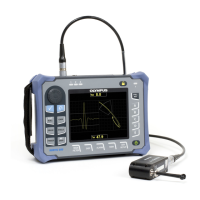DMTA-10040-01EN, Rev. E, February 2018
Chapter 5258
Figure 5‑191 A dual exciter probe
Additionally, dual exciter probes provide an equal response on both sides of the
support because there is always one exciter providing energy to allow detection (see
Figure 5-192 on page 258).
Figure 5‑192 Equal response on both sides of a support with a dual exciter probe
The use of dual frequency and mixing can highly enhance the inspection results. The
main enhancement made by a MIX channel in RFT is the reduced minimum distance
from the support at which a defect can be reliably detected. With a typical (single
frequency) configuration, a corrosion pit can be detected from a distance equivalent to
about one tube OD (outside diameter) thickness away from the support. When using
a properly calibrated MIX channel, this distance is eliminated and pits can be
detected even when they are partially covered by the support.
Lead pickup (absolute
channel)
Lead exciterTrail pickupTrail exciter
The support shields the
pickups from the magnetic
field.
The short defect comparison: voltage plane
(top) and strip chart (bottom).
The ABS channel is more difficult to interpret,
because a defect generates three signals (instead
of two for a single exciter).

